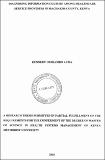| dc.description.abstract | Good health services are those characterized by distinctive information cultures. It is unmanageable to systematically describe the information culture of an organization. This study was carried out to establish the information culture cultivated. The objectives of the study sought to systematically describe information technological practices, information management practices, resources and behavior values that can characterize the desired information culture of an institution, and whether this culture has an effect on information demand and use. A cross-sectional, descriptive method was utilized, adopting qualitative and quantitative data collection approaches. 235 respondents were selected using stratified proportionate sampling method in the five purposively selected public hospitals participated in the survey. The primary methods of data collection comprising both semi-structured questionnaire for the survey and an interview schedule. Data was collected by a structured validated and reliable (r = 0.8) questionnaire and an interview schedule, after a completed consent from the subjects. Data analysis using SPSS Version 22 was carried out and results presented in graphs, charts and mostly inferential statistical tables. It was established that usage of information was average as the highest average was 55.0%. Females were 119(68.8%) compared to their male counter parts who had 54 (31.2%) respondents. There were 114(65.9%) diploma holders, who were the majority with those attaining masters at 7(4.0%). Machakos hospital (24.2%) has the highest number of those with Masters at 22 respondents, while Kathiani (7.7%) had the least at 2 respondents. Most of the respondents (23.1%), were aged between 26-30 years, followed closely (21.4%) by ages 31-35. On comprehensiveness of the information, all four health facilities had high as Machakos county hospital recording the highest average 73 (80.1%) and while Matuu sub county hospital had an average of 16(61.3%). Chi square tests showed significant relationships between having written roles, supervisions, and responsibilities, and ability to share data generated. The p-values for the 4 health facilities were carried out at 5% level of significance and the results are presented in the Table 4.5. On the aspect of usability, it was significant in only two health facilities i.e. Machakos and Matuu (p<0.05) while comprehensiveness was significant among all the four health facilities (p<0.05). Resource utilization was significant in three health facilities i.e. Kangudo, Machakos and Matuu (p<0.05) as compared to motivation, which was significant in two health facilities i.e. Machakos and Matuu (p<0.05). Inaddition, supervision was significant in three facilities i.e. Kangundo, Machakos and Matuu (p<0.05). The use of policy & guidelines, information management (both explicit and tacit) were all significant in all the four health facilities. A significant relationship was found between usability and motivation of staff and accuracy and comprehensiveness of patient information. It was concluded that, key factors that affect information practices, attitudes to information management, and information flows should be identified and managed as these would spur good information culture that is key in service provision. Recommendations were to improve health information system training, improve support supervision and enhance the underpinnings for decision-making. Further research to explore the effects of electronic health records (ERR) on patient information management was recommended. | en_US |

